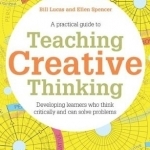Teaching Creative Thinking: Developing Learners Who Think Critically and Can Solve Problems
BookThis item doesn’t have any media yet
2017 | Education
Teaching Creative Thinking is action-oriented and research-led and is packed with examples and case studies of successful practice, and pitfalls to avoid. As well as being subject matter and skill experts, teachers have a vital third role, cultivating what Bill Lucas and Ellen Spencer call capabilities. These are sometimes called dispositions, habits of mind or soft skills, but regardless of the terminology used, schools play a vital role in developing these attributes in their students. Where once it was enough to know and do things, our uncertain world calls for some additional learning. Teaching Creative Thinking explores the ways in which teachers can help learners to cultivate the dispositions which evidence suggests are going to be valuable to them both at school and in later life. Creative thinking is original, purposeful and valuable. In many ways, creative thinking is a social activity and it usually takes place in response to an issue or problem facing an individual or group. Creative thinkers are inquisitive, collaborative, imaginative, persistent and disciplined: all key abilities that schools can help learners to develop.
Successful students value knowledge and skills at the same time as understanding the importance of developing their capabilities as learners in every lesson they experience. Effective pedagogy will always involve the teacher modelling the capabilities he or she values. These include a willingness to take risks, to collaborate with colleagues and to question their own understanding and their own readiness to learn. Schools which really embed capabilities rapidly realise that, for this approach to be sustainable and authentic, they need to be creative in engaging children and young people, giving them new roles, creating new co-curricular opportunities and partnering with a range of external community groups. There are many examples which will inspire schools to do just this. Teaching Creative Thinking explores various pedagogical approaches, including problem-based learning, deliberate practice, growth mindsets, playful experimentation and the classroom as a learning community. It offers practical suggestions about how key capabilities can best be developed in learners, building both theoretical and practical confidence in the kinds of pedagogies which work well.
Suitable for both primary and secondary teachers as well as leaders who want to embed a capabilities approach in their school.
Related Items:
| Published by | Crown House Publishing |
| Edition | Unknown |
| ISBN | 9781785832369 |
| Language | N/A |
Images And Data Courtesy Of: Crown House Publishing.
This content (including text, images, videos and other media) is published and used in accordance
with Fair Use.
